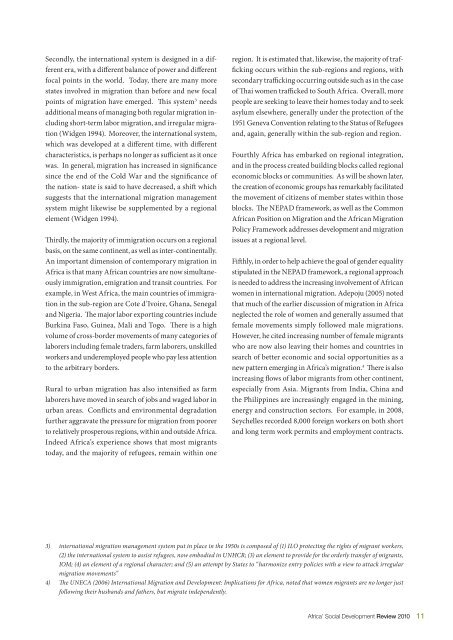The African Social Development Review - United Nations Economic ...
The African Social Development Review - United Nations Economic ...
The African Social Development Review - United Nations Economic ...
Create successful ePaper yourself
Turn your PDF publications into a flip-book with our unique Google optimized e-Paper software.
Secondly, the international system is designed in a differentera, with a different balance of power and differentfocal points in the world. Today, there are many morestates involved in migration than before and new focalpoints of migration have emerged. This system 3 needsadditional means of managing both regular migration includingshort-term labor migration, and irregular migration(Widgen 1994). Moreover, the international system,which was developed at a different time, with differentcharacteristics, is perhaps no longer as sufficient as it oncewas. In general, migration has increased in significancesince the end of the Cold War and the significance ofthe nation- state is said to have decreased, a shift whichsuggests that the international migration managementsystem might likewise be supplemented by a regionalelement (Widgen 1994).Thirdly, the majority of immigration occurs on a regionalbasis, on the same continent, as well as inter-continentally.An important dimension of contemporary migration inAfrica is that many <strong>African</strong> countries are now simultaneouslyimmigration, emigration and transit countries. Forexample, in West Africa, the main countries of immigrationin the sub-region are Cote d’Ivoire, Ghana, Senegaland Nigeria. <strong>The</strong> major labor exporting countries includeBurkina Faso, Guinea, Mali and Togo. <strong>The</strong>re is a highvolume of cross-border movements of many categories oflaborers including female traders, farm laborers, unskilledworkers and underemployed people who pay less attentionto the arbitrary borders.Rural to urban migration has also intensified as farmlaborers have moved in search of jobs and waged labor inurban areas. Conflicts and environmental degradationfurther aggravate the pressure for migration from poorerto relatively prosperous regions, within and outside Africa.Indeed Africa’s experience shows that most migrantstoday, and the majority of refugees, remain within oneregion. It is estimated that, likewise, the majority of traffickingoccurs within the sub-regions and regions, withsecondary trafficking occurring outside such as in the caseof Thai women trafficked to South Africa. Overall, morepeople are seeking to leave their homes today and to seekasylum elsewhere, generally under the protection of the1951 Geneva Convention relating to the Status of Refugeesand, again, generally within the sub-region and region.Fourthly Africa has embarked on regional integration,and in the process created building blocks called regionaleconomic blocks or communities. As will be shown later,the creation of economic groups has remarkably facilitatedthe movement of citizens of member states within thoseblocks. <strong>The</strong> NEPAD framework, as well as the Common<strong>African</strong> Position on Migration and the <strong>African</strong> MigrationPolicy Framework addresses development and migrationissues at a regional level.Fifthly, in order to help achieve the goal of gender equalitystipulated in the NEPAD framework, a regional approachis needed to address the increasing involvement of <strong>African</strong>women in international migration. Adepoju (2005) notedthat much of the earlier discussion of migration in <strong>African</strong>eglected the role of women and generally assumed thatfemale movements simply followed male migrations.However, he cited increasing number of female migrantswho are now also leaving their homes and countries insearch of better economic and social opportunities as anew pattern emerging in Africa’s migration. 4 <strong>The</strong>re is alsoincreasing flows of labor migrants from other continent,especially from Asia. Migrants from India, China andthe Philippines are increasingly engaged in the mining,energy and construction sectors. For example, in 2008,Seychelles recorded 8,000 foreign workers on both shortand long term work permits and employment contracts.3) international migration management system put in place in the 1950s is composed of (1) ILO protecting the rights of migrant workers,(2) the international system to assist refugees, now embodied in UNHCR; (3) an element to provide for the orderly transfer of migrants,IOM; (4) an element of a regional character; and (5) an attempt by States to “harmonize entry policies with a view to attack irregularmigration movements”4) <strong>The</strong> UNECA (2006) International Migration and <strong>Development</strong>: Implications for Africa, noted that women migrants are no longer justfollowing their husbands and fathers, but migrate independently.Africa’ <strong>Social</strong> <strong>Development</strong> <strong>Review</strong> 201011
















